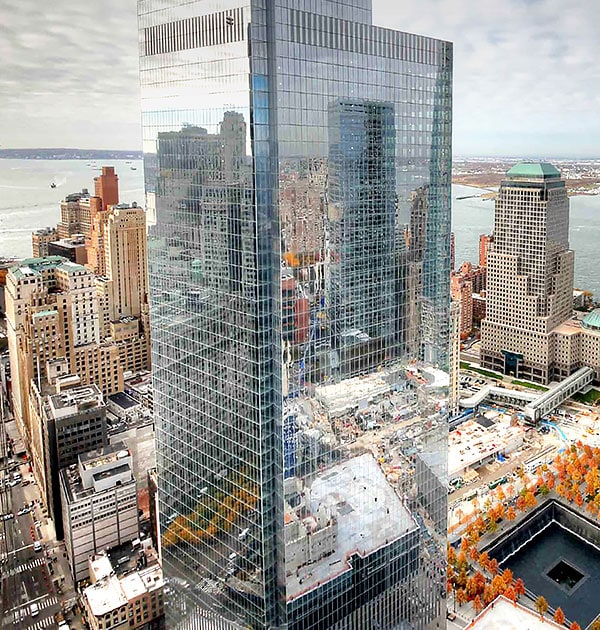Worldwide Sites
You have been detected as being from . Where applicable, you can see country-specific product information, offers, and pricing.
Keyboard ALT + g to toggle grid overlay
Autodesk Vault flexible collaboration tools helped Benson better connect and share files with global teams
Established in Portland, Oregon in 1926, Benson Industries has grown into the world leader in the design, engineering, and fabrication of custom curtainwall and façade systems. But as the company’s business expanded, the need to collaborate across time zones with a wider range of teams began complicating design processes. By adopting Vault collaboration tools, such as Autodesk Shared Views and Fusion Team, Benson overcame communication challenges with streamlined collaboration efforts and accelerated design processes, resulting in 40% fewer product errors, 50% faster processes, 30% reduction in lost documentation, and 30% faster response times.
Biggest buildings in the world rely on Benson

Benson Industries, Inc. is the premier custom curtainwall and external cladding subcontractor in the United States and Asia. With a portfolio that includes the UN Secretariat Building in New York, the Salesforce Tower in San Francisco, the Wilshire Grand Hotel in Los Angeles, The Marina Bay Sands Hotel in Singapore, and The Tower One (Freedom Tower) at Ground Zero in New York City, Benson has worked on the most iconic construction projects in the world.
Established in Portland, Oregon in 1926, Benson has since expanded its operation to Los Angeles, New York, Singapore, and Manila with a full-time assembly shop in Otay Mesa, Mexico. “We do everything, including designing, manufacturing, putting the units together, and installing them on the building,” says Benson Industries Inventor Administrator Radu Stancescu. “Every project is different because every building is different.”
Communication barriers lead to business failure

To streamline design processes across a globally dispersed and complex enterprise, Stancescu invested in Autodesk Vault for product data management, AutoCAD for 2D modeling, and Inventor for 3D mechanical design, documentation, and advanced product simulation.
But as Benson’s business expanded, the company’s need to collaborate across time zones with a wider range of internal and external teams, including tier one and tier two contractors and suppliers, became more complicated. He confessed that email, phone, paper-based processes, as well as VPN and FTP, were causing collaboration barriers, which in turn led to critical shipping delays, design errors, and quality failure.
“We used to just send emails and wait for a response from our foreign offices, but that created long email threads that made finding questions and answers difficult,” says Stancescu. “Email was taking too long to solve problems and phone was not a solution because of the time zone differences. And using FTP to share files with other locations also presented issues, because the other party may not have been granted access to the file, maybe the server was down, or other restrictions.”
To reduce product errors, accelerate time to market, improve collaboration across the global enterprise, and maximize its investment in its Autodesk products, Benson turned to Autodesk’s collaboration tools, specifically Shared Views and Fusion Team, to improve data and knowledge sharing and streamline design processes.
Collaboration tools for today’s manufacturers

Shared Views enabled Benson’s design team to create online visual representations of models and designs; this, according to Stancescu, was “a perfect tool” for sharing a file with a customer for approval or providing sales teams easy web access to files for on-site presentations without the need to access a complete CAD application.
“Shared Views solved everything for us by enabling us to share document views between our offices and outside teams,” says Stancescu. “Shared Views enables a very fast collaboration process compared with old-fashioned methods. We know who said what and when, and it’s all very clear. Also, you know exactly which people are involved.”
Shared Views allows disparate teams across the Benson enterprise to add comments, markups, and screenshots, as well as print and support 2D and robust 3D formats. “What’s especially nice is that in 3D, you don't need to open the document on your computer,” he said. “You can zoom in, zoom out, pan, orbit, fit it to the screen, and more. It's a tool that has everything you need.”

In addition to Shared Views, Stancescu championed Benson’s adoption of Fusion Team, the cloud-based centralized source to create, manage, and share project data, review and discuss designs, track project updates, and comment and mark up projects.
“The difference between the 2 collaboration applications is that Shared Views allows you to share information, but you cannot download anything—it's just a communication tool,” says Stancescu. “But Fusion Team allows you to share information from Vault with other contractors who don’t have access to Vault outside the office.“
He continued, “When something gets shared from Vault to Fusion Team, design teams get instant access to thousands of documents immediately whereas with VPN they’d wait three hours. Now we don’t have to share documents on an FTP site. It is actually saving us hours and hours, and we know it is accurate because it goes straight from Vault to the computer.”
Design delays reduced by 50%, product errors by 40%

Today’s innovative product companies realize the ability to foster collaboration across disparate manufacturing teams and stakeholders is key to successfully managing quality and maximizing business results. As Benson’s investment in Autodesk design and manufacturing tools, which started with AutoCAD and Inventor, expanded to Vault and then ultimately included Shared Views and Fusion Team, deepened—the subsequent ROI grew exponentially.
“Switching AutoCAD and 2D to Inventor and 3D helped us a lot,” says Stancescu. “It’s way faster, more accurate, and easier to use. I’d say our design delays were reduced by 50% and product errors lowered by 40%; from there, we needed a solution to better share documentation because we were stuck using FTP, phone or emails and teams, which caused file version confusion.”
He continued, “When we implemented Vault to all our offices, we got 30% reduction in lost documents due to enhanced traceability, stability, and accuracy. By adding Shared Views and Fusion Team saved us an additional 10% with design process acceleration because these collaboration tools fostered faster communication.”
Benson partners with architects, designers, contractors, and building owners, providing a multi-disciplined approach to tackle the performance, aesthetics, and economic precision required in the design and construction of signature buildings. An often-overlooked benefit of ensuring teams are all working from the latest file version is a reduction in employee errors, scrap and rework costs, and blame. To enhance communication, especially between architecture and manufacturing, a centralized cloud workspace will be the next investment.
“In our design process, we have architects sharing information with us,” says Stancescu. “Because of that, we are actually looking at a new collaboration solution like Autodesk BIM 360, which would enable us to share information, especially documents in Vault, faster with architectural and civil engineering teams. With architects, we still use email, FTP sites, and emails. We have some work to be done there.”
“The business benefits are worth it”

So why haven’t more companies across manufacturing, product design and architectural industries invested in collaboration tools already proven to substantially improve new product development and introduction processes? According to Stancescu, it comes down to a corporate fear of change.
“When it comes to collaboration tools, many companies and administrators are afraid to step in and go to the next level because they don't know what they are missing,” he says. “For instance, we were using AutoCAD, but we want to improve our design processes, so we added Inventor, then we wanted to improve documents sharing, so we got Vault. Then we wanted to talk to each other better, so we added Shared Views then Fusion Team.”
He continued, “Now we’re looking at BIM 360 Docs to save more time and money and provide greater ROI and all that good stuff. My advice to other companies is that when it comes to improving collaboration, you must be willing to adapt and take risks. The business benefits are worth it.”
Related products
Ready to get more out of your machines?
Use Autodesk software to produce higher quality parts straight from your machines.